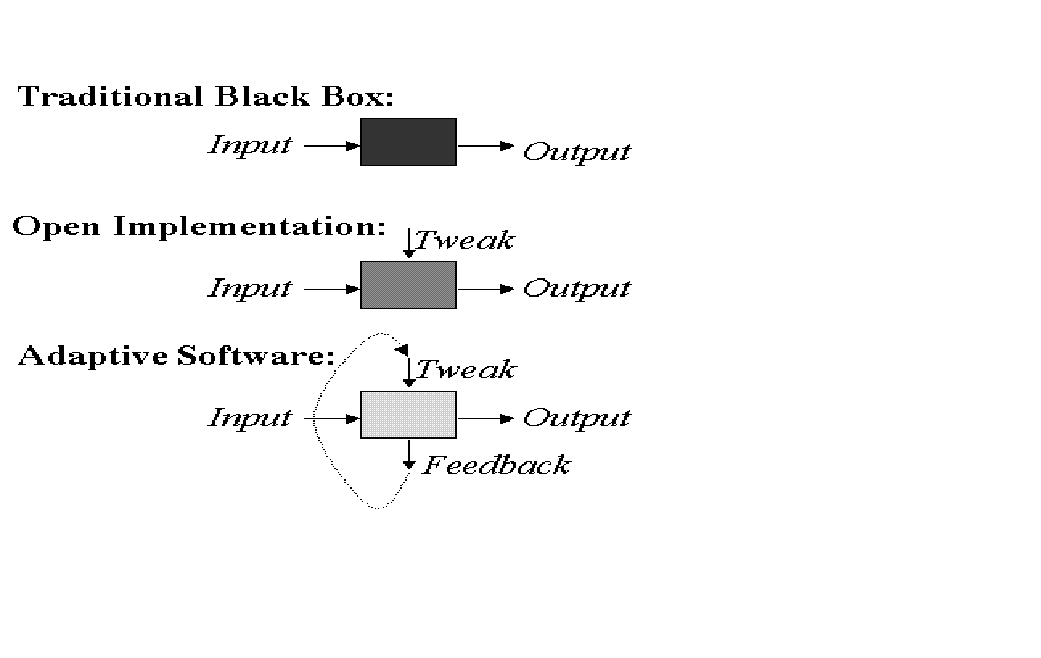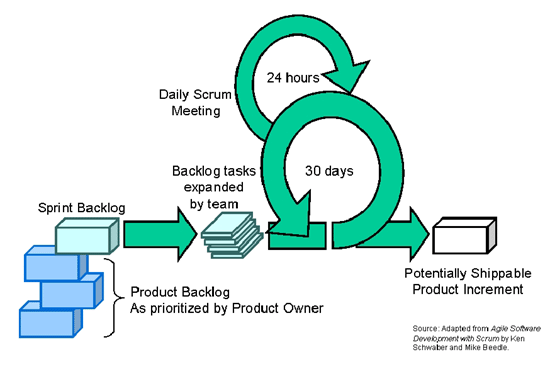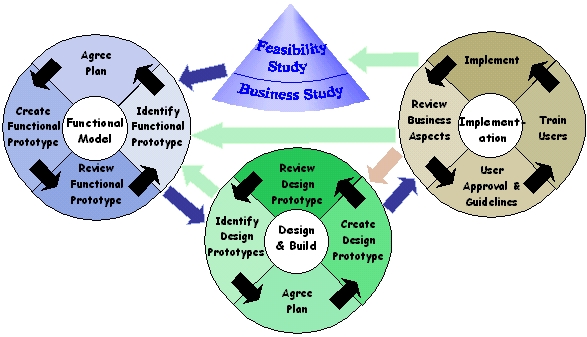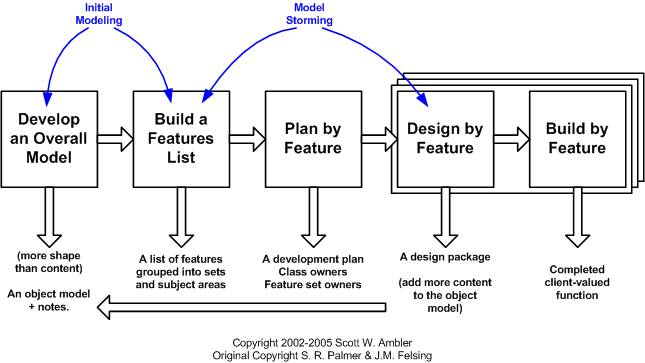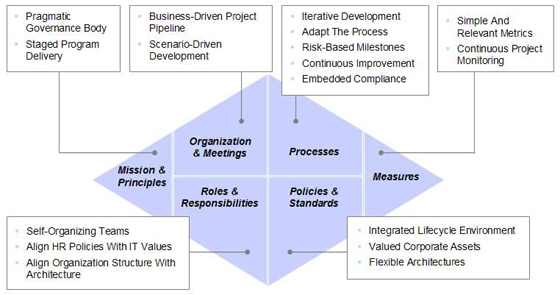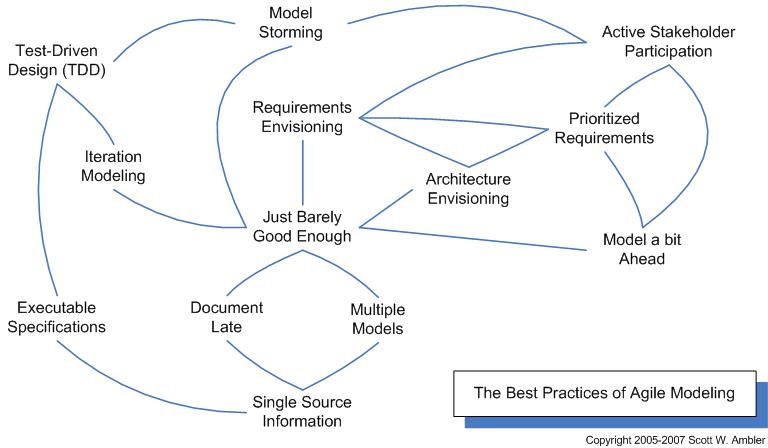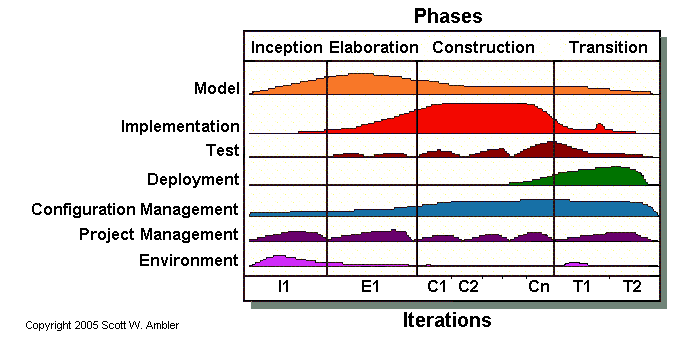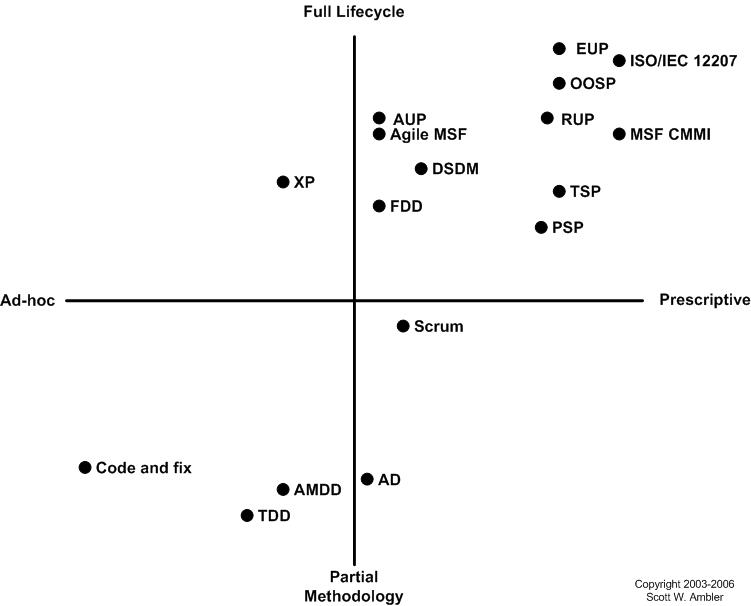CSC/ECE 517 Fall 2009/wiki3 11 ab: Difference between revisions
| (25 intermediate revisions by 2 users not shown) | |||
| Line 8: | Line 8: | ||
== What is Agile ? == | == What is Agile ? == | ||
Agile methodology is a type of project management used for software development.This method uses incremental,iterative work cadences known as [http://en.wikipedia.org/wiki/Sprint_(software_development) sprints] to help teams deal with unpredictability in building software | [http://en.wikipedia.org/wiki/Agile_software_development Agile methodology] is a type of project management used for software development.This method uses incremental,iterative work cadences known as [http://en.wikipedia.org/wiki/Sprint_(software_development) sprints] to help teams deal with unpredictability in building software | ||
== Why Agile? == | == Why Agile? == | ||
In a development life cycle Agile methodology provides many opportunities to access the direction of a project.This approach is achieved by sprints which are regular cadences of work,at the end of which teams must present a shippable increment of work.Agile methodology is hence "iterative" or incremental since it focuses on repetition of abbreviated work cycles as well as the functional product they yield.In contrast in waterfall methodology teams only have have one chance to get each aspect of a project right.Whereas in agile methodology throughout the life cycle of a project every aspect of a development - requirements ,design ,etc - is continually revisited.There is always time to steer the project in another direction when a team stops and re-evaluates the project every two weeks. | In a development life cycle [http://en.wikipedia.org/wiki/Agile_software_development Agile methodology] provides many opportunities to access the direction of a project.This approach is achieved by sprints which are regular cadences of work,at the end of which teams must present a shippable increment of work.Agile methodology is hence "iterative" or incremental since it focuses on repetition of abbreviated work cycles as well as the functional product they yield.In contrast in waterfall methodology teams only have have one chance to get each aspect of a project right.Whereas in agile methodology throughout the life cycle of a project every aspect of a development - requirements ,design ,etc - is continually revisited.There is always time to steer the project in another direction when a team stops and re-evaluates the project every two weeks. | ||
<p> Development costs and time to market are greatly reduced to inspect and adapt way of development .Because teams can gather requirements at the same time they’re gathering requirements, the phenomenon known as analysis paralysis can’t really impede a team from making progress.The stakeholders get recurring opportunities to calibrate releases for success in real world as the team's work cycle is limited to two weeks .The probability of building the right product by the companies is hence high with agile methodology.Instead of committing to market a piece of software that hasn’t even been written yet, agile empowers teams to optimize their release as it’s developed, to be as competitive as possible in the marketplace.In conclusion agile methodology is a very viable option for stakeholders and developers as it ensures to preserve product's critical market relevance and ensure's team's work does not wind up in a shelf .</p> | <p> Development costs and time to market are greatly reduced to inspect and adapt way of development .Because teams can gather requirements at the same time they’re gathering requirements, the phenomenon known as analysis paralysis can’t really impede a team from making progress.The stakeholders get recurring opportunities to calibrate releases for success in real world as the team's work cycle is limited to two weeks .The probability of building the right product by the companies is hence high with agile methodology.Instead of committing to market a piece of software that hasn’t even been written yet, agile empowers teams to optimize their release as it’s developed, to be as competitive as possible in the marketplace.In conclusion agile methodology is a very viable option for stakeholders and developers as it ensures to preserve product's critical market relevance and ensure's team's work does not wind up in a shelf .</p> | ||
| Line 25: | Line 25: | ||
# Agile Modeling (AM) | # Agile Modeling (AM) | ||
# Agile Unified Process (AUP) | # Agile Unified Process (AUP) | ||
=== Adaptive Software Development (ASD)=== | === Adaptive Software Development (ASD)=== | ||
| Line 31: | Line 32: | ||
[[Image:Ada.gif]] | [[Image:Ada.gif]] | ||
Image Courtesy :http://norvig.com | |||
=== Scrum === | === Scrum === | ||
| Line 49: | Line 52: | ||
[[Image:Dsdm.jpg]] | [[Image:Dsdm.jpg]] | ||
Image Courtesy http://www.codeproject.com/KB/architecture | |||
=== Crystal === | === Crystal === | ||
The development of Crystal Methods took place to encounter the variability of the environment and the characteristics that are unique to a project.The primary difference between RUP and Crystal is that while RUP generally starts with a plan-driven base methodology and tailors down for smaller, less critical projects, on the other hand, the Crystal according to the author Alistair Cockburn the base methodology should be “barely sufficient.” According to him , “You need one less notch control than you expect, and less is better when it comes to delivering quickly.” | The development of [http://agile.csc.ncsu.edu/SEMaterials/AgileMethods.pdf Crystal] Methods took place to encounter the variability of the environment and the characteristics that are unique to a project.The primary difference between RUP and Crystal is that while RUP generally starts with a plan-driven base methodology and tailors down for smaller, less critical projects, on the other hand, the Crystal according to the author Alistair Cockburn the base methodology should be “barely sufficient.” According to him , “You need one less notch control than you expect, and less is better when it comes to delivering quickly.” | ||
According to another belief by Cockburn, Crystal is a family of methods because that there is no "one-size-fits all" development process. As such, the different methods are assigned colors arranged in ascending opacity; the most agile version is Crystal Clear, followed by Crystal Yellow, Crystal Orange, and Crystal Red.The Crystal Methods emphasize the importance of people in developing software. "It focuses on people, interaction, community, skills, talents, and communication as first order effects on performance. Process remains important, but secondary”. There are only two absolute rules of the Crystal family of methodologies. Firstly, incremental cycles should not exceed four months. Secondly, reflection workshops must be held after every delivery so that the methodology is self-adapting. Currently, only Crystal Clear and Crystal Orange have been defined | According to another belief by Cockburn, Crystal is a family of methods because that there is no "one-size-fits all" development process. As such, the different methods are assigned colors arranged in ascending opacity; the most agile version is Crystal Clear, followed by Crystal Yellow, Crystal Orange, and Crystal Red.The Crystal Methods emphasize the importance of people in developing software. "It focuses on people, interaction, community, skills, talents, and communication as first order effects on performance. Process remains important, but secondary”. There are only two absolute rules of the Crystal family of methodologies. Firstly, incremental cycles should not exceed four months. Secondly, reflection workshops must be held after every delivery so that the methodology is self-adapting. Currently, only Crystal Clear and Crystal Orange have been defined | ||
| Line 61: | Line 65: | ||
Image Courtesy : http://www.devx.com/architect/Article/32836/1763?supportItem=2 | Image Courtesy : http://www.devx.com/architect/Article/32836/1763?supportItem=2 | ||
=== Feature Drive Development (FDD)=== | === Feature Drive Development (FDD)=== | ||
[http://www.agilemodeling.com/essays/fdd. | [http://www.agilemodeling.com/essays/fdd.htm Feature-Driven Development](FDD) is a client-centric, architecture-centric, and pragmatic software process. As the name implies, features are an important aspect of FDD. A feature is a small, client-valued function expressed in the form <action><result><object>. For example, “Calculate the total of a sale”, “Validate the password of a user”, and “Authorize the sales transaction of a customer”. Features are to FDD as use cases are to the Rational Unified Process (RUP) and user stories are to XP – they’re a primary source of requirements and the primary input into your planning efforts. | ||
[[Image:LifecycleFDD.gif]] | [[Image:LifecycleFDD.gif]] | ||
Image Courtesy: http://www.agilemodeling.com/essays/fdd.htm | |||
=== Lean Software Development (LSD)=== | === Lean Software Development (LSD)=== | ||
Lean software development is a translation of lean manufacturing principles and practices to the software development domain. Adapted from the Toyota Production System, a pro-lean subculture is emerging from within the Agile community | [http://en.wikipedia.org/wiki/Lean_software_development Lean software development] is a translation of lean manufacturing principles and practices to the software development domain. Adapted from the Toyota Production System, a pro-lean subculture is emerging from within the Agile community. | ||
[[Image:Lean_Software_Development.jpg]] | [[Image:Lean_Software_Development.jpg]] | ||
Courtesy : | Image Courtesy : http://www.ibm.com/developerworks/rational/library/jun07/kroll/ | ||
=== Agile Modeling (AM)=== | === Agile Modeling (AM)=== | ||
| Line 82: | Line 87: | ||
[[Image:BestPractices.jpg]] | [[Image:BestPractices.jpg]] | ||
Image Courtesy: http://www.agilemodeling.com/ | |||
=== Agile Unified Process (AUP)=== | === Agile Unified Process (AUP)=== | ||
| Line 88: | Line 95: | ||
[[Image:LifecycleAgileUP.gif]] | [[Image:LifecycleAgileUP.gif]] | ||
Image Courtesy: http://www.ambysoft.com/unifiedprocess/agileUP.html | |||
== Comparing Development Methods == | == Comparing Development Methods == | ||
The leading development methods are compared in Table 1.The focus is not on use case modelling ,rather on high-level software processes therefore RUP and not detailed methods.The table lists the development methods that appear in reasonably common use and it is not exhaustive .Table 1 includes advice for when to apply the method, some of the situations overlap which reflects the fact that you have a methodological choice.Figure 1 depicts a graph comparing the same processes.The table also indicates primary types of modeling artifacts that you are likely to create following each method.The artifacts are listed “in order” of creation although the reality is that most models are created iteratively, even when you are following so-called serial processes.Some of the secondary models are not listed ,for example business rules and user interface prototypes on a RUP project ,since those artifacts are nto focus of the method .the primary focus of this table is to showcase different approaches to development ch of which has it’s own collection of primary modeling artifacts. Each method is applicable to certain types of situations, so it is to your advantage to understand each method and to pick the one best suited for your current situation.It is important to understand that the advice regarding when to use a method is fairly general and should be taken with a grain of salt. | The leading development methods are compared in Table 1.The focus is not on use case modelling ,rather on high-level software processes therefore RUP and not detailed methods.The table lists the development methods that appear in reasonably common use and it is not exhaustive .Table 1 includes advice for when to apply the method, some of the situations overlap which reflects the fact that you have a methodological choice.Figure 1 depicts a graph comparing the same processes.The table also indicates primary types of modeling artifacts that you are likely to create following each method.The artifacts are listed “in order” of creation although the reality is that most models are created iteratively, even when you are following so-called serial processes.Some of the secondary models are not listed ,for example business rules and user interface prototypes on a RUP project ,since those artifacts are nto focus of the method .the primary focus of this table is to showcase different approaches to development ch of which has it’s own collection of primary modeling artifacts. Each method is applicable to certain types of situations, so it is to your advantage to understand each method and to pick the one best suited for your current situation.It is important to understand that the advice regarding when to use a method is fairly general and should be taken with a grain of salt. | ||
'''Table 1 | |||
''' | |||
{| {{table}} | {| {{table}} | ||
| Line 107: | Line 119: | ||
| Agile Unified Process (AUP) ||An agile instantiation of the Unified Process (UP), a dramatic simplification of the RUP. ||When you want something in between XP and traditional RUP, a process that is agile yet explicitly includes activities and artifacts which you\'re accustomed to, or simply something that\'s free. ||Use-case model UML sequence diagrams UML class model Physical data model | | Agile Unified Process (AUP) ||An agile instantiation of the Unified Process (UP), a dramatic simplification of the RUP. ||When you want something in between XP and traditional RUP, a process that is agile yet explicitly includes activities and artifacts which you\'re accustomed to, or simply something that\'s free. ||Use-case model UML sequence diagrams UML class model Physical data model | ||
|- | |- | ||
| Code and Fix ||A typically ineffective approach to development, usually followed by unskilled or poorly skilled developers, where they simply write code without putting much thought into it. Also called | | Code and Fix ||A typically ineffective approach to development, usually followed by unskilled or poorly skilled developers, where they simply write code without putting much thought into it. Also called "hacking" or "immature development". ||For throw-away prototypes. ||Source code | ||
|- | |- | ||
| Data-Driven Approach ||This is a generic category of data-driven methods popularized in the 1970s and 1980s with the emergence of structured methods. This approach is typical rigorous and serial. For a humorous look, read The Glacial Methodology ||Development of a data warehouse, although a usage-centered approach is still preferable. Development of a simple “CRUD” (Create Read Update Delete) business application. ||Conceptual data model Logical data model Deployment architecture Physical data model | | Data-Driven Approach ||This is a generic category of data-driven methods popularized in the 1970s and 1980s with the emergence of structured methods. This approach is typical rigorous and serial. For a humorous look, read The Glacial Methodology ||Development of a data warehouse, although a usage-centered approach is still preferable. Development of a simple “CRUD” (Create Read Update Delete) business application. ||Conceptual data model Logical data model Deployment architecture Physical data model | ||
| Line 146: | Line 158: | ||
There is another very good link to understand the usage of various Agile methodologies : http://balagan.org.uk/work/agile_comparison.htm | There is another very good link to understand the usage of various Agile methodologies : http://balagan.org.uk/work/agile_comparison.htm | ||
'''Figure 1''' | |||
[[Image:ProcessComparisons.jpg]] | |||
== Strengths and Weaknesses == | == Strengths and Weaknesses == | ||
Latest revision as of 03:08, 19 November 2009
A COMPARATIVE ANALYSIS OF OTHER AGILE METHODOLOGIES AND ASSESSING THEIR STRENGTHS AND WEAKNESSES
Although, the most popular Agile methodology is Extreme Programming (XP) there are other other methodologies which are also used in the industry such as Adaptive Software Development (ASD), Scrum, Dynamic Systems Development Method (DSDM), Crystal etc. that we shall be covering in this Wikipedia. Moreover, we will perform a comparative analysis between these process models and conclude with the criteria for selecting a particular agile methodology.
What is Agile ?
Agile methodology is a type of project management used for software development.This method uses incremental,iterative work cadences known as sprints to help teams deal with unpredictability in building software
Why Agile?
In a development life cycle Agile methodology provides many opportunities to access the direction of a project.This approach is achieved by sprints which are regular cadences of work,at the end of which teams must present a shippable increment of work.Agile methodology is hence "iterative" or incremental since it focuses on repetition of abbreviated work cycles as well as the functional product they yield.In contrast in waterfall methodology teams only have have one chance to get each aspect of a project right.Whereas in agile methodology throughout the life cycle of a project every aspect of a development - requirements ,design ,etc - is continually revisited.There is always time to steer the project in another direction when a team stops and re-evaluates the project every two weeks.
Development costs and time to market are greatly reduced to inspect and adapt way of development .Because teams can gather requirements at the same time they’re gathering requirements, the phenomenon known as analysis paralysis can’t really impede a team from making progress.The stakeholders get recurring opportunities to calibrate releases for success in real world as the team's work cycle is limited to two weeks .The probability of building the right product by the companies is hence high with agile methodology.Instead of committing to market a piece of software that hasn’t even been written yet, agile empowers teams to optimize their release as it’s developed, to be as competitive as possible in the marketplace.In conclusion agile methodology is a very viable option for stakeholders and developers as it ensures to preserve product's critical market relevance and ensure's team's work does not wind up in a shelf .
A Brief look at other Agile methodologies
- Adaptive Software Development (ASD)
- Scrum
- Dynamic Systems Development Method (DSDM)
- Crystal
- Feature Drive Development (FDD)
- Lean Software Development (LSD)
- Agile Modeling (AM)
- Agile Unified Process (AUP)
Adaptive Software Development (ASD)
Adaptive Software Development evolved out of the work by Jin Highsmith and Sam Bayer on the rapid application development. It follows the principle that continuous change to a process is a normal behaviour expected out of it. It differs from the traditional waterfall model in the sense that is has concurrent processes of speculate,collaborate, and learn cycles. Because of it, the project undergoes continuous changes at any stage of its development and is therefore, dynamic in operation. Some of the characteristics of an adaptive software development life cycle are that it is iterative, time-boxed, driven by risk, flexible to changes and it is overall focused on its mission.
Image Courtesy :http://norvig.com
Scrum
Scrum is an incremental framework that is iterative and used for managing complex work (such as new product development) and is categorized under agile software development.Scrum is a "process skeleton," which contains sets of practices and predefined roles. The main roles in Scrum are: the "ScrumMaster", who maintains the processes (typically in lieu of a project manager); the "Product Owner", who represents the stakeholders; the "Team", a cross-functional group of about 7 people who do the actual analysis, design, implementation, testing, etc.
Image Courtesy : http://www.methodsandtools.com/archive/archive.php?id=18
Dynamic Systems Development Method (DSDM)
Dynamic Systems Development Method (DSDM) is an agile software development methodology that is actually based upon the Rapid Application Development methodology. Of one of the principles in DSDM, user involvement is one of the main keys in running an efficient and effective project where both users and developers work together at t common workplace so that the decisions are accurate. Moreover, it is expected that all changes made during the development are reversible. Testing exists throughout the life-cycle of project. DSDM is an iterative and incremental approach that emphasises continuous user involvement.Its goal is to deliver software systems on time and on budget while adjusting for changing requirements along the development process. DSDM is one of a number of Agile methods for developing software, and it forms a part of the Agile Alliance.
Image Courtesy http://www.codeproject.com/KB/architecture
Crystal
The development of Crystal Methods took place to encounter the variability of the environment and the characteristics that are unique to a project.The primary difference between RUP and Crystal is that while RUP generally starts with a plan-driven base methodology and tailors down for smaller, less critical projects, on the other hand, the Crystal according to the author Alistair Cockburn the base methodology should be “barely sufficient.” According to him , “You need one less notch control than you expect, and less is better when it comes to delivering quickly.”
According to another belief by Cockburn, Crystal is a family of methods because that there is no "one-size-fits all" development process. As such, the different methods are assigned colors arranged in ascending opacity; the most agile version is Crystal Clear, followed by Crystal Yellow, Crystal Orange, and Crystal Red.The Crystal Methods emphasize the importance of people in developing software. "It focuses on people, interaction, community, skills, talents, and communication as first order effects on performance. Process remains important, but secondary”. There are only two absolute rules of the Crystal family of methodologies. Firstly, incremental cycles should not exceed four months. Secondly, reflection workshops must be held after every delivery so that the methodology is self-adapting. Currently, only Crystal Clear and Crystal Orange have been defined
The Crystal Family of Methodologies.One characteristics of Crystal is its intentional scaling to projects based on size and criticality. The larger a project gets (from left to right), the darker the color.
Image Courtesy : http://www.devx.com/architect/Article/32836/1763?supportItem=2
Feature Drive Development (FDD)
Feature-Driven Development(FDD) is a client-centric, architecture-centric, and pragmatic software process. As the name implies, features are an important aspect of FDD. A feature is a small, client-valued function expressed in the form <action><result><object>. For example, “Calculate the total of a sale”, “Validate the password of a user”, and “Authorize the sales transaction of a customer”. Features are to FDD as use cases are to the Rational Unified Process (RUP) and user stories are to XP – they’re a primary source of requirements and the primary input into your planning efforts.
Image Courtesy: http://www.agilemodeling.com/essays/fdd.htm
Lean Software Development (LSD)
Lean software development is a translation of lean manufacturing principles and practices to the software development domain. Adapted from the Toyota Production System, a pro-lean subculture is emerging from within the Agile community.
Image Courtesy : http://www.ibm.com/developerworks/rational/library/jun07/kroll/
Agile Modeling (AM)
Agile Modeling (AM) is a practice-based methodology for effective modeling and documentation of software-based systems. At a high level AM is a collection of best practices, depicted in the pattern language map below . At a more detailed level AM is a collection of values, principles, and practices for modeling software that can be applied on a software development project in an effective and light-weight manner.
Image Courtesy: http://www.agilemodeling.com/
Agile Unified Process (AUP)
AUP is a simplified version of the Rational Unified Process (RUP). It describes a simple, easy to understand approach to developing business application software using agile techniques and concepts yet still remaining true to the RUP.
Image Courtesy: http://www.ambysoft.com/unifiedprocess/agileUP.html
Comparing Development Methods
The leading development methods are compared in Table 1.The focus is not on use case modelling ,rather on high-level software processes therefore RUP and not detailed methods.The table lists the development methods that appear in reasonably common use and it is not exhaustive .Table 1 includes advice for when to apply the method, some of the situations overlap which reflects the fact that you have a methodological choice.Figure 1 depicts a graph comparing the same processes.The table also indicates primary types of modeling artifacts that you are likely to create following each method.The artifacts are listed “in order” of creation although the reality is that most models are created iteratively, even when you are following so-called serial processes.Some of the secondary models are not listed ,for example business rules and user interface prototypes on a RUP project ,since those artifacts are nto focus of the method .the primary focus of this table is to showcase different approaches to development ch of which has it’s own collection of primary modeling artifacts. Each method is applicable to certain types of situations, so it is to your advantage to understand each method and to pick the one best suited for your current situation.It is important to understand that the advice regarding when to use a method is fairly general and should be taken with a grain of salt.
Table 1
| Method | Description | When to Use It | Primary Modeling Artifacts |
| Agile Data (AD) | A partial agile method which focuses on techniques which support evolutionary (iterative and incremental) database development. | Tailor the AD philosophies and techniques into other evolutionary processes. | Agile data models |
| Agile Model Driven Development (AMDD) | A partial, practices-based method which describes techniques for effective modeling and documentation of systems. | Tailor the AM principles and practices into other agile or near-agile processes. | Apply the right artifact for the situation at hand. |
| Agile MSF (Microsoft Solutions Framework) | TBD | TBD | TBD |
| Agile Unified Process (AUP) | An agile instantiation of the Unified Process (UP), a dramatic simplification of the RUP. | When you want something in between XP and traditional RUP, a process that is agile yet explicitly includes activities and artifacts which you\'re accustomed to, or simply something that\'s free. | Use-case model UML sequence diagrams UML class model Physical data model |
| Code and Fix | A typically ineffective approach to development, usually followed by unskilled or poorly skilled developers, where they simply write code without putting much thought into it. Also called "hacking" or "immature development". | For throw-away prototypes. | Source code |
| Data-Driven Approach | This is a generic category of data-driven methods popularized in the 1970s and 1980s with the emergence of structured methods. This approach is typical rigorous and serial. For a humorous look, read The Glacial Methodology | Development of a data warehouse, although a usage-centered approach is still preferable. Development of a simple “CRUD” (Create Read Update Delete) business application. | Conceptual data model Logical data model Deployment architecture Physical data model |
| Dynamic System Development Method (DSDM) | This is an agile method that has received ISO 9001 certification. In many ways it is a formalization of the Rapid Application Development (RAD) methods of the 1980s. | Development of a user interface intensive system. Complex business application. | Functional prototype Design prototype |
| Enterprise Unified Process (EUP) | A rigorous, seven-phase software process that includes development, operation, and retirement of software-based systems. Development efforts are iterative and incremental. It includes a multi-system view that includes enterprise architecture, reuse management, portfolio management, and people management activities. | Need to manage a portfolio of projects, including but not limited teams following the RUP. You have been successful at several RUP projects and wish to now take the full system lifecycle into account. | Enterprise business model Enterprise domain architecture model Enterprise technical architecture model Project-level artifacts |
| Extreme Programming (XP) | An agile development method that focuses on the critical activities required to build software. | Small, co-located project teams (4-10 people). Requirements are uncertain. Good relationship (potentially) exists with project stakeholders. | User stories Architectural metaphor/strategy Class responsibility collaborator (CRC) cards |
| Feature-Driven Development (FDD) | An agile development method based on short iterations which includes explicit modeling activities. | Small project team (4-20 people). Requirements are uncertain. Team willing to follow a modeling driven approach. | Domain class/object model Features UML Sequence diagrams UML class model |
| Glacial Methodology | TBD | TBD | TBD |
| ICONIX | A simple, modeling-driven method that can be instantiated as an improvement to the RUP or as an agile method in its own right. | Small to medium sized project teams (4 to 20 people). Business application development. | Use-case model Robustness diagrams UML Sequence diagrams UML class model |
| ISO/IEC 12207 | A multi-phase software process that includes development, operation, and retirement of software-based systems. | Medium to large project teams (20+ people). Mandated (e.g. by government) to follow this approach. | Shall statements Logical data model Logical process model Physical data model Physical process model |
| MSF for CMMI (Microsoft Solutions Framework for Capability Maturity Model Integrated) | TBD | TBD | TBD |
| Object Oriented Software Process (OOSP) | A rigorous, CMM Level 5 (when fully instantiated), process whose focus is on the development, operations, support, and maintenance of systems using object-oriented and/or component based technologies. | Medium to large project teams (10+ people). | Use-case model System architecture model UML Sequence diagrams UML class model Physical data model |
| Personal Software Process (PSP) | A prescriptive software process for individual developers. | 1 (see the TSP for the group version) | TBD |
| Rational Unified Process (RUP) | A rigorous, four-phase software development process which is iterative and incremental. | Medium to large project teams (10+ people). | Use-case model System architecture model UML Sequence diagrams UML class model Physical data model |
| Scrum | An agile method whose focus is on project management and requirements management. Often combined with XP. | Any size project | Varies, depending on the development process (XP, ...) which you use Scrum with. |
| Team Software Process (TSP) | TBD | TBD | TBD |
| Test Driven Development (TDD) | An evolutionary approach to development where you must first write a test that fails before you write new functional code. Also known as test-first programming or test-first development | Any size project | Tests |
http://www.agiledata.org/essays/differentStrategies.html
There is another very good link to understand the usage of various Agile methodologies : http://balagan.org.uk/work/agile_comparison.htm
Figure 1
Strengths and Weaknesses
Every methodology has it's strengths and weaknesses. The following table can be used in assessing the right methodology for working on a project.
| Strengths | Weaknesses | |
| XP | Strong technical practices. Customer ownership of feature priority, developer ownership of estimates. Frequent feedback opportunities. Most widely known and adopted approach, at least in the U.S. | Requires onsite customer. Documentation primarily through verbal communication and code. For some teams these are the only artifacts created, others create minimal design and user documentation. Difficult for new adopters to determine how to accommodate architectural and design concerns. |
| Scrum | Complements existing practices. Self organizing teams and feedback. Customer participation and steering. Priorities based on business value. Only approach here that has a certification process. | Only provides project management support, other disciplines are out of scope. Does not specify technical practices. Can take some time to get the business to provide unique priorities for each requirement. |
| Lean | Complements existing practices. Focuses on project ROI. Eliminates all project waste. Cross-functional teams. | Does not specify technical practices. Requires constant gathering of metrics which may be difficult for some environments to accommodate. Theory of Constraints can be a complex and difficult aspect to adopt. |
| FDD | Supports multiple teams working in parallel. All aspects of a project tracked by feature. Design by feature and build by feature aspects are easy to understand and adopt. Scales to large teams or projects well. | Promotes individual code ownership as opposed to shared/team ownership. Iterations are not as well defined by the process as other Agile methodologies. The model-centric aspects can have huge impacts when working on existing systems that have no models. |
| AUP | Robust methodology with many artifacts and disciplines to choose from. Scales up very well. Documentation helps communicate in distributed environments. Priorities set based on highest risk. Risk can be a business or technical risk. | Higher levels of ceremony may be a hindrance in smaller projects. Minimal attention to team dynamics. Documentation is much more formal than most approaches mentioned here. |
| Crystal | Family of methodologies designed to scale by project size and criticality. Only methodology that specifically accounts for life critical projects. As project size grows, cross-functional teams are utilized to ensure consistency. The \"human\" component has been considered for every aspect of the project support structure. An emphasis on testing is so strong that at least one tester is expected to be on each project team. | Expects all team members to be co-located. May not work well for distributed teams. Adjustments are required from one project size/structure to another in order to follow the prescribed flavor of Crystal for that project size/criticality. Moving from one flavor of Crystal to another in mid project doesn\'t work, as Crystal was not designed to be upward or downward compatible. |
| DSDM | An emphasis on testing is so strong that at least one tester is expected to be on each project team. Designed from the ground up by business people, so business value is identified and expected to be the highest priority deliverable. Has specific approach to determining how important each requirement is to an iteration. Sets stakeholder expectations from the start of the project that not all requirements will make it into the final deliverable. | Probably the most heavyweight project compared in this survey. Expects continuous user involvement. Defines several artifacts and work products for each phase of the project; heavier documentation. Access to material is controlled by a Consortium, and fees may be charged just to access the reference material. |
The next table shows a comparison among the methodologies based on certain parameters such as Small Team, Highly Volatile Requirements, Distrbuted Teams, High Ceremony Culture,High Criticality Sytems and Multiple Customers/Stakeholders. According to the author, the table does not represent any scientific metrics for evaluating the adoption criteria for any methodology. The aim is to help out a team in picking out the best possible methodology suitable for their project
| Condition | XP | Scrum | Lean | FDD | AUP | Crystal | DSDM |
| Small Team | √ | √ | √ | X | X | - | √ |
| Highly Volatile Requirements | √ | √ | √ | √ | - | - | X |
| Distributed Teams | X | √ | √ | √ | √ | X | X |
| High Ceremony Culture | X | X | - | - | √ | - | √ |
| High Criticality Systems | X | - | - | - | - | √ | X |
| Multiple Customers / Stakeholders | X | √ | √ | - | - | - | X |
Reference : http://www.devx.com/architect/Article/32836/0/page/4
Conclusion
As visible from the table of comparisons above each software development methodology is suited in a particular team and project setting .The project team and stakeholders need to decide on the methodology based on the size of team ,time required to develop and market the product and other parameters .The decision should help make the quality of product better and meet the deadline in time to market or sell the product .Below is table which summarizes each of the software development methodology in one phrase
| Methodology | Summarizing Phrase |
| XP | Simplicity |
| Scrum | Prioritized Business Value |
| Lean | Return on Investment (ROI) |
| FDD | Business Model |
| AUP | Manage Risk |
| Crystal | Size and Criticality |
| DSDM | Current Business Value |
References
- http://agilemethodology.org/
- http://en.wikipedia.org/wiki/Scrum_%28development%29
- http://en.wikipedia.org/wiki/Dynamic_Systems_Development_Method
- http://agile.csc.ncsu.edu/SEMaterials/AgileMethods.pdf
- http://www.agilemodeling.com/essays/fdd.htm
- http://en.wikipedia.org/wiki/Lean_software_development
- http://www.agilemodeling.com/
- http://www.ambysoft.com/unifiedprocess/agileUP.html
- http://www.agiledata.org/essays/differentStrategies.html
- http://balagan.org.uk/work/agile_comparison.htm
- http://www.devx.com/architect/Article/32836/0/page/4
